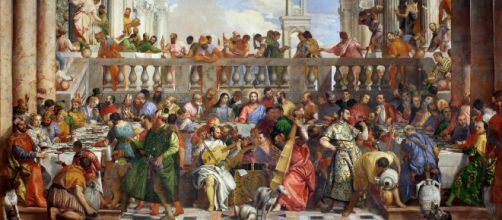Weaponizing art for political gain could be the subtitle for Cynthia Salman’s book "Plunder: Napoleon’s Theft of Veronese’s Feast." The paintings the military leader stole to fill the Louvre – originally called "Musee Napoleon" – are so numerous that the toll remains untold.
So innumerable was his loot from Italy, Holland, Flanders, and Germany that if returned to the rightful owners, there wouldn’t be a Louvre as we know it anymore.
Just one
So, it’s odd that Salzman singled out just one of Napoleon’s ill-gotten gains that she characterized as “violently yanked” off the wall of a Venetian monastery for which it was specifically painted.
Her book doesn’t focus on the painting so much as keying in on the journey it made from Italy to France. Art Daily praises the recounting as “expertly researched and deftly told.”
Pinpointing the path to Paris rather than the painting is unexpected until you find that Salzman is not an art historian, but rather a sociologist.
The painting
What you see in the painting is Christ changing water into wine. But, like all big weddings, it’s hard to connect to any one individual. Christ is lost in the crowd. And in a way, that same minimizing of Christ occurred when Napoleon’s soldiers ripped the painting from its religious setting at the monastery.
But why pick only Veronese’s painting out of the horde that Napoleon ran off with?
Art News unwittingly provided the answer by noting the painting’s extensive size – 32 feet long. If you’re a showoff like Napoleon who wanted the world to see you as all-powerful, stealing showy artwork certainly would give you street creds.
Big hit
How praiseworthy is the Veronese painting? Salzman notes many accolades beginning with all the fans at the monastery.
The Wedding at Cana was so admired that by 1705, she said the monks felt compelled to restrict the mobs that came to see it.
After installation at the Louvre, the painting continued to attract attention. (Hung opposite the Mona Lisa likely helps). Art star of the 18th century, Jacques-Louis David, called the Veronese painting “the “greatest known picture in the world.” He loved it so much that he painted his own equally long version titled The Coronation of Napoleon.
Napoleon’s cache of stolen works at the Louvre is so extensive that Salzman writes how the museum had come to look like what Napoleon imagined – a collection that would make Paris “the new Rome.”
Mood painting
But here’s the thing. While the vastness and detail of Veronese’s painting are impressive as hell, it’s almost undigestible. My choice for a painting to connect to at the Louvre is a less-heralded, far simpler painting by Renaissance artist Piero di Cosimo known as Madonna of the Dove.
There are many Madonna and Child paintings in the Louvre, but none like Cosimo’s Mary who looks ordinary in every way down to her rustic clothes. Also, unlike other Madonna paintings that center on the infant, Cosimo paid attention to Mary’s s state of mind.
He pictures her as distracted and blue as if she knows what’s going to happen to her child when he is grown.
Mary’s child also is made ordinary-looking – squirming away from her to reach a white dove (said to be the Holy Spirit). The realism in this painting is so striking, so graphic that it takes you in and holds you fast. What you see is what Peter Schjeldahl, The New Yorker art critic, justly calls Cosimo’s “downright humanity.”


